Managing a project is a bit like completing a Rubik’s cube — you have to keep several elements of the project at the top of your mind, while also considering multiple different outcomes and how long the route to completion will take.
Along the way, you’re bound to hit some bumps in the road. With projects, some struggles are more common than others, including issues regarding scope, budget, communication, and more.
In this article, we’ll walk you through 12 of the most common project management challenges and show you how to overcome them.
Get started1. Setting clear goals and objectives
Getting clear on what you need to do is critical for successful project completion.
Failure to set appropriate goals and objectives can lead to a whole host of issues, including poor resource and stakeholder management.
In fact, a recent survey revealed that a lack of clear goals is the most common factor (37%) for project failure.
Goals should be clearly stated and realistic, and broken down into achievable project milestones. You should also show how every action taken moves you closer to achieving the goal. This means you can measure the impact of the team and individual project members.
How to set clear goals and objectives
- Use a goal-setting frameworks: Choose one or a blend of these two popular frameworks:
- SMART: Specific, Measurable, Achievable, Relevant, and Time-bound.
- CLEAR: Collaborative, Limited, Emotional, Appreciable, and Refinable.
- Conduct a project kickoff meeting. Gather all stakeholders to discuss the project’s scope, goals, and project constraints to align everyone’s understanding from the start.
- Break the project down into simple tasks. You should then assign those tasks to the most appropriate people, with clear goals and objectives outlined.
- Use project planning software. With monday work management, project leaders can build custom goal trackers to set goals and timelines quarterly so that it’s easy to follow up and check on progress.
2. Scope creep
Scope creep is a classic project management challenge that refers to how the requirements of a project change from what was initially agreed at project initiation.
It’s common — PMI reported that 34% of projects globally were impacted by scope creep — but it doesn’t need to cause too much drama if managed effectively.
Take this hypothetical example from the construction industry:
A client makes unauthorized changes to the initial drawings of a building. The changes have a bearing on both deliverables and the purpose of the project.
Managing this scope change is possible within the project team if an increase in funds or project duration can be agreed.
Pro tip: want to streamline your project execution and avoid some of the biggest challenges? Use monday work management. It’s your go-to project management platform for all your project needs.
How to deal with scope creep
- Define clear project requirements. Document the project scope, objectives, deliverables, and timeline in detail at the start. Get stakeholder approval on this scope document to establish a clear baseline.
- Implement change control processes. Create a formal change management plan that outlines procedures for requesting, reviewing, and approving any changes to the project scope.
- Communicate regularly with stakeholders. Keep all stakeholders informed about project progress and any potential scope changes. Resurface the original project scope if stakeholders start pushing for additions.
- Monitor progress closely. Use project management tools to track tasks, resources, and timelines to help identify potential scope creep early. An Agile project management methodology like Scrum will allow your team to focus on specific goals while continuously reviewing priorities and plans. Try the Scrum sprint planning template from monday.com.
3. Budget restrictions and changes
When scope starts to creep while managing projects, so does the budget. Budget management can pose a big challenge for project managers.
For example, let’s say a project manager on the marketing team discovers that to promote a new product, she’ll need to increase her online advertising spend from what she initially planned. If the campaign is necessary, the manager may request more funds or stretch what she has to work with.
Project managers must plan their budgets accurately and ensure that projects remain within budget. They should adopt efficient cost management strategies to stay within the agreed-upon budget.
How to deal with budget restrictions and changes
- Regularly monitor and update the budget. Keep a close eye on expenses and compare them to the planned budget to identify potential overruns early and take corrective action. The monday work management budget tracker helps project managers stay on track within their budget, with real-time views showing the total spent compared to the remaining work.
- Implement change control processes. Establish a formal procedure for reviewing and approving any changes to the project scope or budget. This helps prevent scope creep and uncontrolled spending.
- Communicate transparently. Keep stakeholders informed about budget constraints and any necessary adjustments. Clear communication helps manage stakeholder expectations and build trust.
- Use contingency funds wisely. If you’ve included a contingency reserve in your budget, use it judiciously to address unexpected costs or changes.
4. Lack of communication
Communication can make or break a project.
Good communication means team members work well together, tasks are allocated efficiently, and stakeholders are kept in the loop about project progress.
Ineffective communication means, well, none of the above.
If there’s an issue with effective communication in your team, you’ll have to roll your sleeves up and tackle it head-on. That might be bringing people together to thrash out a particular problem, or helping to create a project environment where constructive feedback is valued as a tool for improvement.
Effective project management software can help drive good communication practices — though it’s only ever going to get the Oscar for best supporting role.
How to deal with communication issues
- Develop a comprehensive communication plan. Outline communication objectives, target audiences, preferred channels, and frequency of updates.
- Tailor communication to your audience. Adapt your communication style and content to suit different project stakeholders (e.g. technical team vs senior management) and cultures.
- Establish regular check-ins. Schedule recurring team meetings, like daily stand-ups and one-on-ones, to align priorities and address any issues.
- Use appropriate communication tools and technologies. Leverage project management software, collaboration platforms, and communication tools to streamline information sharing.
Here are four ways monday work management can help improve communication in your organization.
- Our status update column type allows you to color-code updates in customizable columns, so you’ll always know where you are at a glance:

- Team members can leave notes on the status column for others to view at their leisure:

- You can remove any confusion over ownership by assigning tasks to individuals:

- Within each task, team members and project managers can communicate by tagging one another, attaching files, and creating to-do lists:

For a deeper dive into how you can use monday.com to facilitate communication with your teams, check out this YouTube video:
5. Team conflict
When asked about project management challenges, lack of strategic direction and leadership was another biggie.
This is a problem, as 14% of project managers reported that lack of direction was a cause of conflict in their projects. Additionally, 12% reported miscommunication and misunderstandings within the team as a major hurdle.
Ignoring team conflict isn’t an option for project managers. You’ll need to figure out the root cause of the issue, then take a deep breath and get it sorted.
How to deal with team conflict
- Acknowledge the conflict. Recognize and address conflicts early before they escalate. Be attentive to signs of tension, disagreements, or communication breakdowns within the team.
- Identify the root cause. Speak with the individuals involved to uncover the underlying issues causing the conflict. Understanding the root cause is essential for finding appropriate solutions.
- Foster a collaborative environment. Emphasize teamwork and mutual respect among team members. Encourage collaboration and support to create a positive work environment.
- Focus on solutions, not blame. Shift the focus from assigning blame to identifying practical solutions that benefit the project. Encourage the team to work together to resolve the issue.
You can also use project management software to tackle this challenge.
With monday work management, it’s easy to view, share, and annotate project documentation. This means the whole team can contribute to a vision document and create a shared sense of purpose. Communication takes place in-platform, meaning everything happens in context and helps reduce misunderstandings.
6. Mismatched team skills
As a project manager, you want to create the best work environment for your team. A productive work environment comes from matching tasks to team members with the right skills to deliver.
If there’s a mismatch between requirements and skill levels, the project will suffer inefficiencies that could lead to failure.
Appropriately matching skills to project tasks requires experience in knowing what skills are necessary for what tasks. It also requires project managers to get to know their team well so they can understand their skills and motivation.
A project manager should constantly assess their workforce to establish whether every team member is being utilized effectively, based on their skills and workload.
How to deal with mismatched team skills
- Assess skills and capabilities. Conduct a thorough assessment of each team member’s skills, experience, and strengths to help identify any skill gaps or mismatches.
- Reassign tasks. Based on the skills assessment, reassign tasks to match each team member’s capabilities better and ensure people are working on tasks they’re best suited for.
- Use a skills matrix. Create a visual representation of team skills to identify gaps and overlaps quickly. This can help with task allocation and identifying areas for improvement.
- Leverage project management software. Use tools to track skills, assign tasks based on capabilities, and monitor progress.
For example, monday work management allows you to track workload and evaluate your team members’ performances. Using the color-coded interface, you can see right away what each team member has to do.
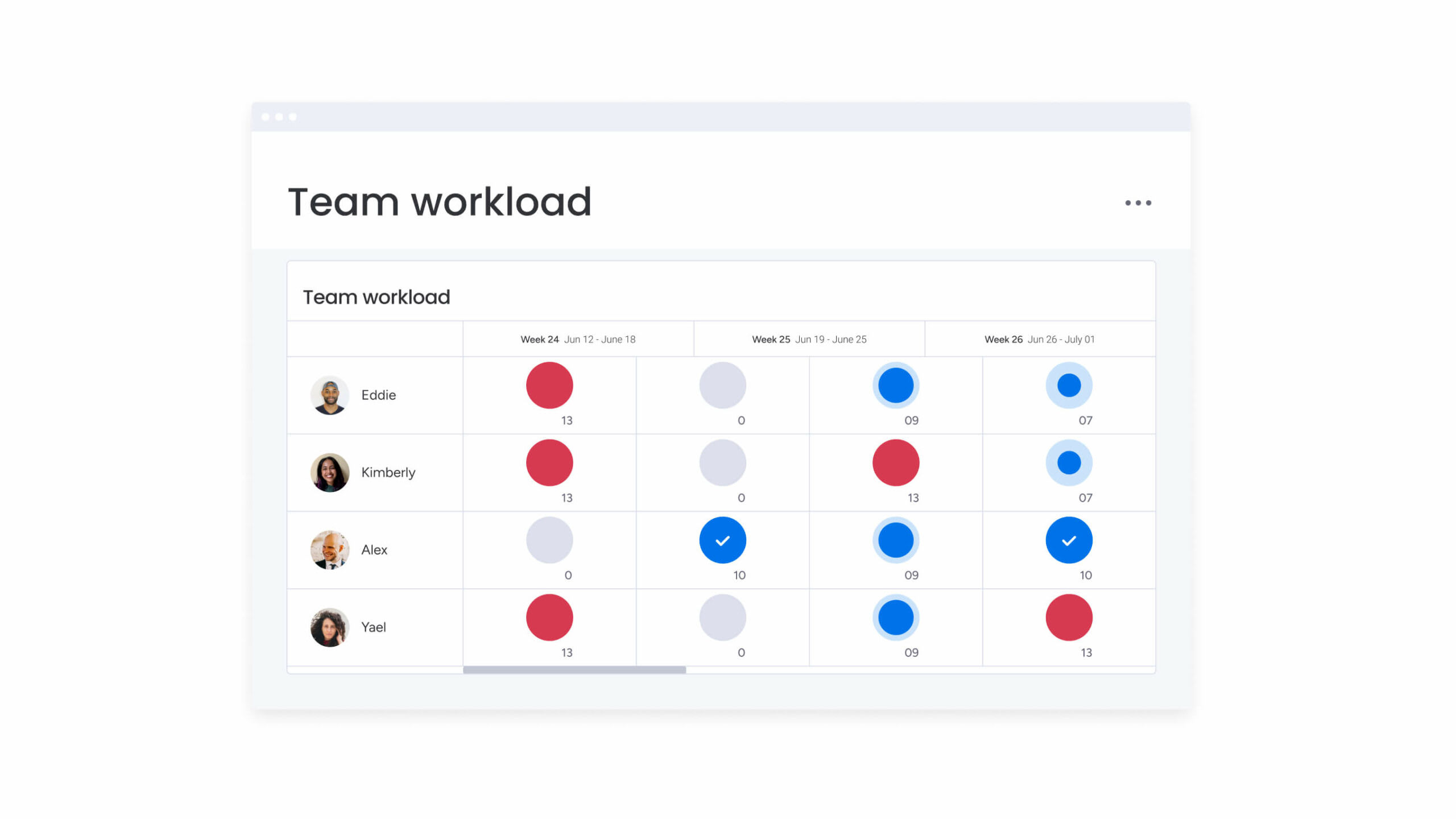
For a deeper dive into how to use Workload View to manage team workload, check out our YouTube video:
7. Absence of accountability
Accountability means every member of your team is responsible for their decisions and actions. This isn’t about handing out blame if things go wrong. It’s empowering your team to get things done the way they want to, without micro-managing their every move.
Accountability in the workplace is associated with an increase in work commitment and higher performance.
However, most project teams lack accountability. When your team members aren’t accountable, commitment to the project goal — and the likelihood of project success — is reduced.
How to deal with a lack of accountability
- Set clear expectations and responsibilities. Clearly define roles, tasks, and deliverables for each team member at the start of the project to ensure everyone understands their responsibilities.
- Lead by example. As the project manager, demonstrate accountability in your own actions and decisions to set the tone for the rest of the team.
- Foster a culture of ownership. Encourage team members to take ownership of their tasks and outcomes. Empower them to make decisions within their areas of responsibility.
- Use project management tools. Implement project management software that allows for task assignment, progress tracking, and visibility into individual contributions.
For example, monday work management allows project managers to keep their teams accountable. The team tasks template enables managers to assign owners to tasks and clearly shows the status and progress during the project lifecycle.

8. Unrealistic deadlines
Have you ever heard the warning: “don’t overpromise and underdeliver?”
We’ve all sat on the sidelines and watched project managers who haven’t heeded these pearls of wisdom. Perhaps we’ve even been those project managers. It’s not pretty.
Ignoring this advice results in missed deadlines, reduced quality, stressed team members, and disappointed stakeholders.
Unrealistic deadlines are a classic way to overpromise, and need to be tackled in the project planning phase.
An effective project manager knows their teams’ strengths and weaknesses and what they can deliver within a specified duration. They can then negotiate for achievable deadlines without rushing the work.
Giving unrealistic deadlines might win you the project, but it’ll also frustrate you and your team, severely affect your work outcomes, and ultimately taint your reputation.
How to deal with unrealistic deadlines
- Evaluate and communicate the reality of the situation. Assess if the deadline is genuinely unrealistic or just challenging. Clearly explain to stakeholders why the original deadline is not feasible, and provide data and evidence to support your position.
- Negotiate for a more reasonable timeline. Propose alternative solutions like reducing scope, changing specifications, or offering different timelines. Be respectful but firm in pushing back on unrealistic expectations.
- Break down the work and prioritize. Divide the project into smaller, manageable tasks and assign each task sufficient time. Prioritize the most critical and high-impact deliverables. Base each estimate on your experience of similar, previously completed work.
- Use project management tools effectively. Leverage software to track progress, deadlines, and dependencies. Use timeline and Gantt chart features to visualize the project schedule, and set up automated alerts for upcoming deadlines.
For example, monday work management has a helpful deadline mode that lets you set and adhere to project timelines. Here, you can see how the deadlines are displayed directly beside the project status:

You can also display deadlines as time spans, so you’re not locked down to a single day:

For more information on using timelines to combat missing deadlines, check out this video:
9. Poor risk management
Project managers have to evaluate and manage risks throughout the life cycle of their projects.
Project managers aren’t psychic, and some risks will occur no matter how much you plan.
However, experienced project managers mitigate the impact of these pesky problems by identifying “what-if” scenarios and devising contingency plans.
As a project manager, you must ensure your team can adapt if things get out of control.
How to deal with poor risk management
- Create a risk register. Develop a comprehensive risk register to document all identified risks, including fields for the risk description, likelihood, impact, owner, response, action, and status. For example, monday work management has a helpful project risk register to help you identify, evaluate, and plan for possible risks.
- Identify and assess risks. Conduct thorough risk identification sessions with key stakeholders and team members to uncover potential risks related to project requirements, technology, budget, and other areas. Assess each risk’s likelihood and impact to prioritize them effectively.
- Develop a mitigation strategy. For each identified risk, establish a mitigation strategy to reduce its likelihood or impact. Standard techniques include avoiding, reducing, transferring, or accepting the risk. Collaborate with stakeholders to determine the most appropriate response based on their risk appetite.
- Assign risk owners. Designate specific team members as risk owners responsible for monitoring and managing assigned risks. This accountability ensures risks are actively managed throughout the project.
10. Lack of stakeholder engagement
A lack of stakeholder engagement occurs when key stakeholders — project managers, team members, senior management, sponsors, clients, partners, investors, suppliers, and end users — are not actively involved in or supportive of the project, leading to misaligned expectations, poor communication, and potential resistance to project outcomes.
Stakeholder disengagement can result in delayed decision-making, inadequate resource allocation, and a lack of buy-in for project goals and deliverables. Overcoming this challenge requires proactive communication, clearly defined stakeholder roles and responsibilities, and consistent efforts to demonstrate the project’s value to all involved parties.
How to deal with a lack of stakeholder engagement
- Identify and prioritize stakeholders. Begin by identifying and categorizing all potential stakeholders based on their interest and influence on the project. This helps in understanding who needs to be engaged and to what extent.
- Develop a comprehensive engagement plan. From your stakeholder analysis, create an engagement strategy that outlines the objectives, roles, and engagement methods for maintaining communication with stakeholders. Try using a RACI matrix template to help visually represent the various stakeholder roles and responsibilities.
- Establish consistent and clear communication channels. Regular updates and check-ins can keep stakeholders informed and involved. Tailor communication — including meetings, surveys, and focus groups — to meet the preferences and expectations of different stakeholders, ensuring that they feel heard and valued.
- Involve stakeholders early and often. Engage stakeholders from the beginning of the project to ensure they feel invested in the process. Early involvement can lead to better support and cooperation as stakeholders believe their input is valued.
11. Resource deprivation
According to an RGPM survey, 44% of project managers say a lack of resources is a common project challenge. This shortage can manifest as inadequate staffing, limited budget, insufficient equipment, or a lack of required expertise.
Resource deprivation often leads to project delays, compromised quality, increased stress on team members, and potential project failure. It requires project managers to allocate resources creatively, prioritize tasks effectively, and potentially renegotiate project scope or timelines with stakeholders to align with available resources.
How to deal with resource deprivation
- Create a resource allocation plan. Develop a detailed plan outlining the project’s resources, including personnel, equipment, and budget. This plan should prioritize critical tasks and allocate resources efficiently to maximize impact and support team goals.
- Identify and leverage alternative resources. Look for alternative resources that you can use to fill gaps. This might include using existing tools in new ways, cross-training team members to handle multiple roles, or seeking partnerships with other departments or organizations to share resources.
- Adjust project scope and priorities. If resources are limited, consider adjusting the project scope to focus on the most critical deliverables. Prioritize tasks that provide the highest value and can be completed with the available resources.
- Communicate with stakeholders. Keep stakeholders informed about resource constraints and their potential impact on the project. Transparent communication can help manage expectations and gain support for resource reallocation or additional funding.
12. Finding effective project management software
While many project managers rely on project management software, some don’t have access to such technology. According to one survey, 28% of project managers say they put dates in a spreadsheet and use that for project scheduling.
The biggest advantage of these platforms is that project managers can access them remotely and track progress in real-time. They also centralize data and enable all stakeholders to access it via multiple devices.
How to select the right project management software
- Identify your needs. Start by assessing your team’s specific requirements. Consider factors such as the size of your team, the complexity of your projects, and the types of tasks you manage. Determine which features are essential, such as task management, resource allocation, collaboration tools, budgeting, and reporting capabilities.
- Research the market. Explore various project management software options available in the market. Resources like lists of the top project management tools can provide insights into popular choices and their unique features. Some well-regarded tools include monday.com for workflow automation, Smartsheet for stakeholder views, and Jira for agile project management.
- Evaluate the features. Compare the features of different software solutions to see which align best with your needs. Key features to look for include project scheduling, budget tracking, task management, collaboration capabilities, and integrations with other apps your team already uses.
- Consider usability and accessibility. Ensure the software is user-friendly and accessible on various devices, including mobile, to accommodate remote or hybrid work environments.
Overcome common challenges with monday work management
The cost of project management challenges can be substantial. Unforeseen issues can result in wasted budget, frustrated top performers, and awkward conversations with senior management when projects overrun.
If you’re looking for a solution to help you do much more than just overcome these project management challenges, check out monday work management — it’s got all the colors of a Rubik’s cube, with none of the frustration.
Built on the customizable monday.com Work OS, monday work management empowers teams to create their dream project management software. It’s easy to use and keeps all data in one central place.
With monday work management, you can tackle every challenge you might face during a project’s life cycle as swiftly and seamlessly as possible.
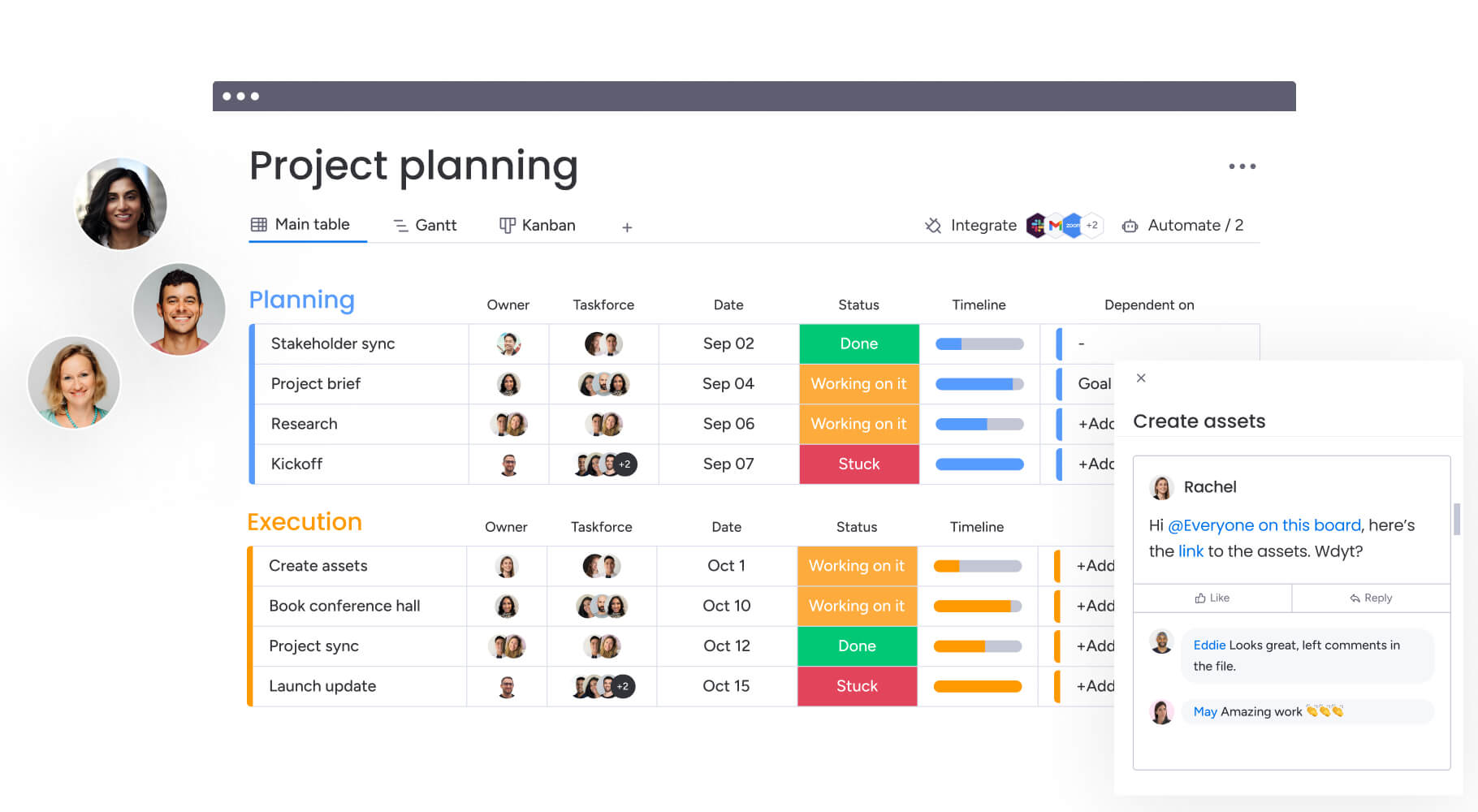
Multiple views
Visualize your data and project plans the way you need with dynamic features and 15+ board views, like Timeline, Kanban, and Gantt charts:
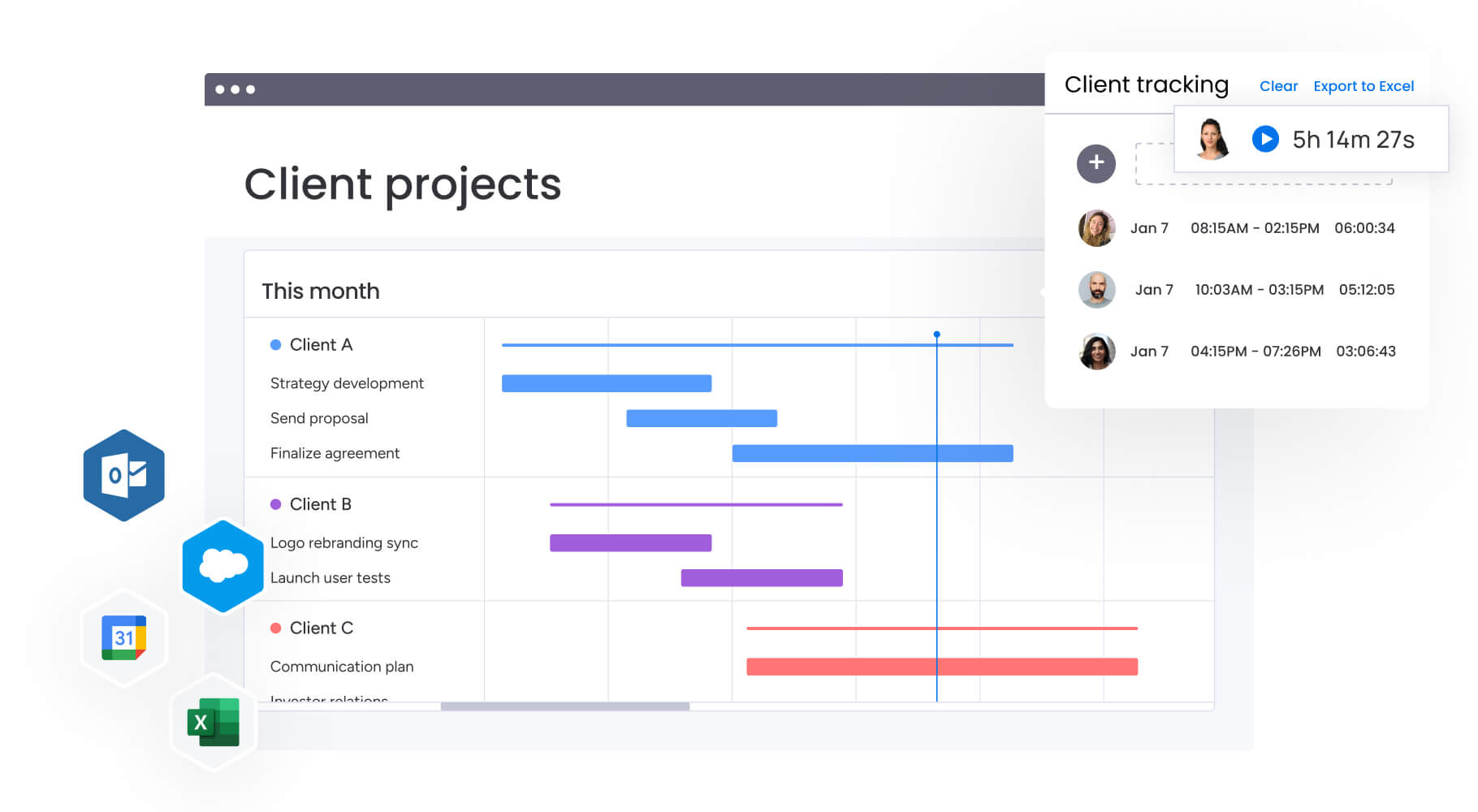
Time-saving automations
You can automate many tasks and notifications so that project lags never occur, including email sends, status updates, and much more:
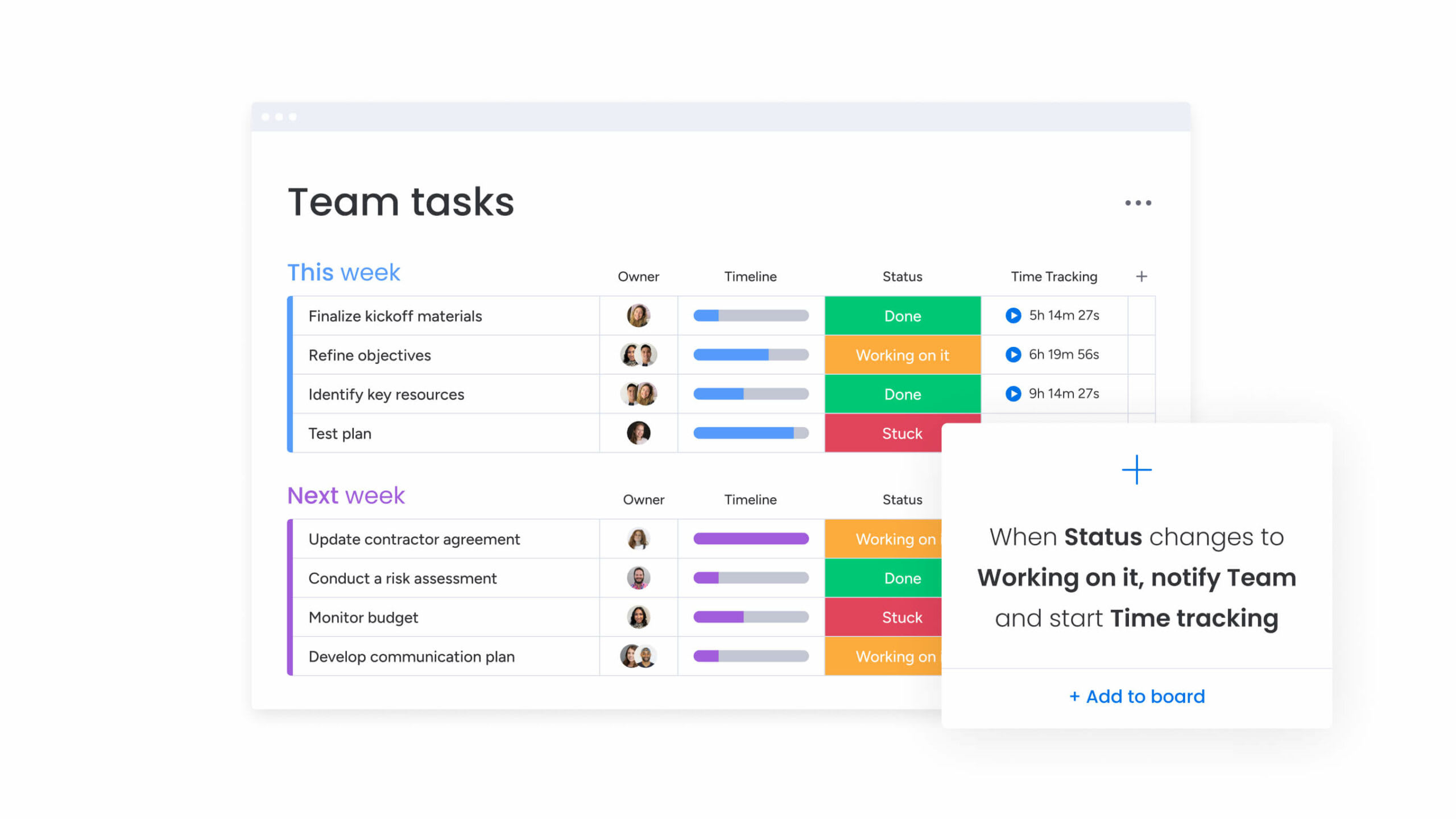
Third party integrations
You can integrate monday work management with the apps and tools you’re already using, such as Gmail, Slack, Salesforce, and Zendesk, to run entire projects without ever switching tabs:
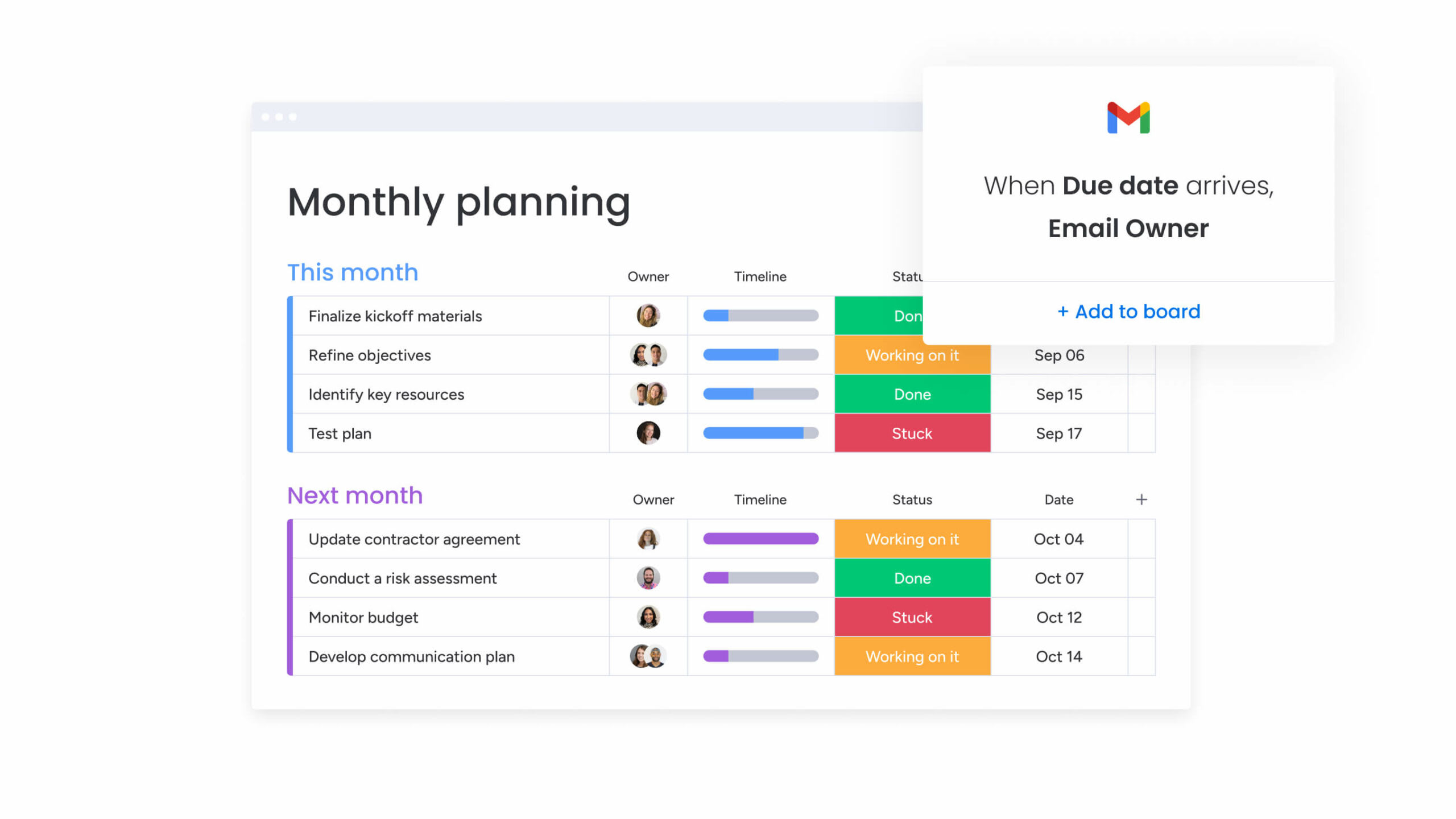
User friendly templates
Choose from 200+ templates so you never have to start from scratch, no matter what type of project you’re handling:
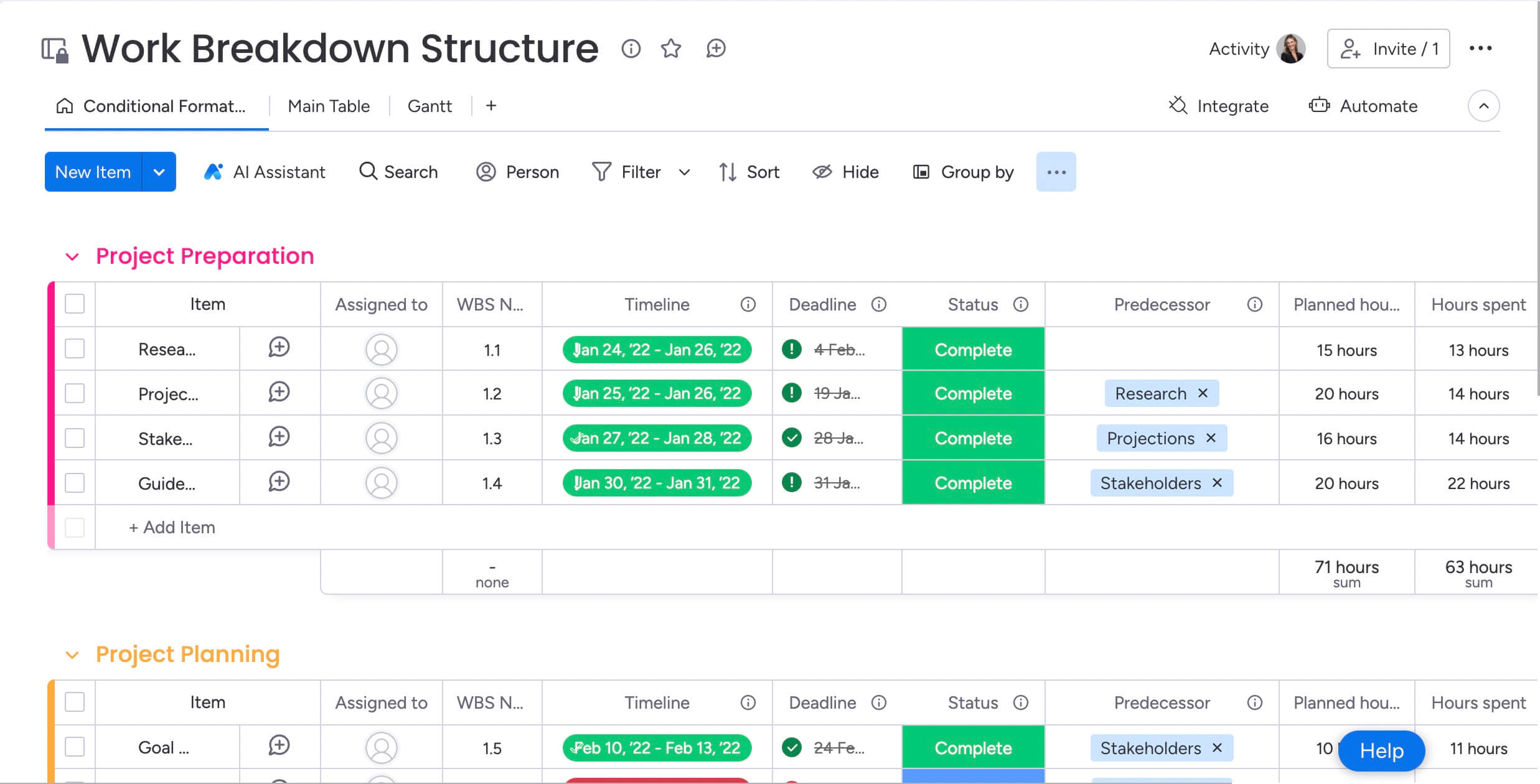
Start your 14-day free trial today to see how you can overcome any project management challenge.
Get startedFAQs
What are the three main challenges in project management?
The three biggest project management challenges are scope creep, poor communication, and resource allocation. You need to have enough budget, time management, good communication skills, and hold regular meetings to control scope creep and finish projects on time.
What are the top challenges facing project managers today?
According to a 2023 survey of 217 project management professionals, the top challenges are:
* Not enough resources (44%)
* Unrealistic deadlines (31%)
* Not having the right resources (26%)
* Insufficient project budget (17%)
* Poor project quality (13%)
* Lack of project schedule (11%)
What is the first challenge faced by project managers?
The first challenge often faced by project managers is team management. This includes building a strong team, setting clear goals, and managing conflicts among team members. Effective team management is crucial for ensuring that everyone is aligned and working towards the same objectives, which can significantly impact the project's overall success.
How do you identify challenges in a project?
To identify challenges in a project, conduct a thorough initial assessment to identify and assess potential risks and then plan appropriate actions to mitigate or avoid them.
What are the triple constraints of project management?
The triple constraints of project management — also known as the "Iron Triangle" or "Project Management Triangle" — are scope, time, and cost. These three constraints are interconnected, and changes to one constraint typically affect the others. For example, increasing the scope often requires more time and/or money. Conversely, cutting the budget might mean extending the timeline or reducing the project's scope.
- Tags:
- Project risk management
 Get started
Get started 

